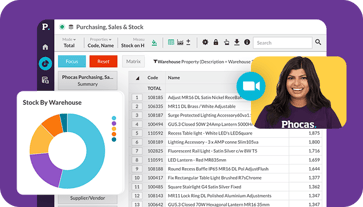5 data trends business managers can monitor to rebound faster
During this time of uncertainty, business managers must have the ability to cut through the noise so they can see what’s happening and understand the changes taking place in their businesses. Accurate and timely data will help you decide which areas of your business are critical and where to focus. Full visibility of your operations allows you to determine data trends so you can make fact based decisions and rebound faster.
Data trend 1: day sales outstanding
Days sales outstanding is the number of days change in accounts receivables (AR), average days out.
These data points should help business managers understand the deviations from “business as usual,” and as they review the information, they should consider the slope or rate of change. Specifically, the slope indicates how quickly a trend is moving in a certain direction, and if the slope is steep, it’s likely it will be going in that direction for a while.
Data trend 2: bookings: percentage of change to order back log
Equally important during this time is not just comparing a current period to a previous period. Rather, companies should be reviewing multiple comparisons because they will want to know how data points impact new data.
As you track change, look at comparisons to see a trajectory, such as demand forecasting and average days to pay. In the current business climate, historical data and backward-looking metrics can be somewhat limited in their value.
Data trend 3: percentage of change invoiced sales volume
Decision-makers look at percentage share of total because they will want to understand if what’s happening now is good, bad or just different. And, are there areas that companies can focus on to help them through this period?
Not only do decision-makers need to know which direction the actual numbers are going, but they also need to understand how those numbers compare to each other and how the mix within those numbers compares over time.
Data trend 4: percentage of change purchase orders placed, $ volume
It is useful to track basic inventory metrics to benchmark such as product turns and return on actual inventory investment. It’s important to understand the impacts in different areas of the business. Not every widget in the warehouse is created equal, making it crucial to understand why customers are buying specific products. How much are they paying for them, and can you resupply it from your current vendors?
Data trend 5: percentage of change inventory on hand, and $ volume
Managers should review what areas of the business you have recognized as the focus to keep moving forward and be strategic about where they can pull back quickly if forecasts weaken. Do you have an understanding of when to reduce inventory based on current or future demand, or will you increase inventory of certain items because of a lack of confidence in a supplier or a damaged supply chain?
As returning to a better normal is considered, it’s important for businesses to plan for how to manage operations as demand gradually increases. Just as companies track the slope during the slow-down, resetting their demand calculations and inventory levels, they will also want to monitor how shallow the slope will be as customers return.


Empowering businesses with intuitive data analytics, driving informed decisions for growth and profitability. We make people feel good about data.
Related blog posts

Asahi Group (a large beverage manufacturer and distributor) recently experienced a cyberattack that didn’t destroy the business, but did create the kind of operational and financial mess most mid-market companies recognize. Orders couldn’t be processed normally, shipments were delayed, call centres were disrupted and some products became temporarily hard to get in retail and hospitality channels. The impact showed up quickly in results. Domestic sales dropped materially for a period while systems were restored and workarounds were put in place.
Read more
Manufacturers, distributors and retailers rely heavily on their suppliers to deliver quality products on time and at the right price. Strong supplier relationship management (SRM) is essential for these industries because it enables you and your suppliers to map out the supply chain, achieve economies of scale and offer customers an extensive choice of products.
Read more
DIFOT (Delivered In-Full, On-Time) or OTIF (On-Time In-Full) is a fundamental KPI when analyzing the performance of your supply chain. The main goal is to get your customers the products they need, when they need them, in the quantity they ordered. DIFOT measures how successful your business is at achieving this objective and identifies procurement problems and supplier reliability.
Read more
Financial planning and analysis (FP&A) provides the insights that drive growth, protect profitability and guide new investments. Done well, FP&A transforms raw financial data into scenario models and forecasts, helping finance leaders and business units move ahead with confidence.
Read moreBrowse by category

Find out how our platform gives you the visibility you need to get more done.
Get your demo today